ITALIAN VIRGINALS
Polygonal virginals are the most numerous of the surviving instruments of the 16th century, many of these having been made in Venice. The earliest identifiable instrument was made by Lorenzo da Pavia probably for Isabella d'Este in 1496, but it is possibly the one made for her sister Beatrice before 1496 and acquired by Isabella after her sister's death. This has only survived in the form of an intarsia in the grotta at the palace of Mantua.
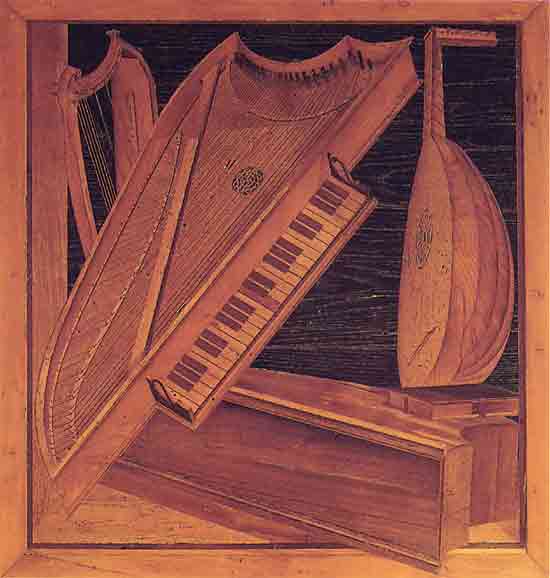
It shows an instrument with curved case sides which follow to some extent the shape of the bridges. Some other early virginals also had curved sides, somewhat like a viol, such as another intarsia of a virginal in the Stanza della Segnatura, in Rome and an instrument in private ownership in Brescia. By 1523 straight-sided instruments had become established, as shown by the virginals of "Francisci de Portalupis Veronensis" seen below. It is indistinguishable from the Venetian case style and may have been made in Venice even though the maker came from Verona. It also uses the high instrumental pitch of 465Hz. This implements an early style of arabesque work, in this example with ivory and ebony marquetry work and must have been a precious instrument in its time.

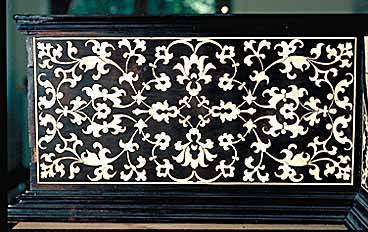
![]() Not all Italian instruments were made with cypress and used boxwood for the natural keycovers, as this Francesco instrument shows. Although often quite simply finished, several were elaborately decorated with intarsia or other decorative work, some of which I show you here.
Not all Italian instruments were made with cypress and used boxwood for the natural keycovers, as this Francesco instrument shows. Although often quite simply finished, several were elaborately decorated with intarsia or other decorative work, some of which I show you here.
Plain cypress cases, as in this unsigned instrument identified as from the workshop of Dominicus Pisaurensis (W461, Museo Civico, Asolo, Italy), were the norm for Venetian virginals, but even such creations are little masterpieces of architectural elegance with their finely cut mouldings and carefully planned proportions. Seven of his virginals are now known and rank among the best of the oeuvre.

However, there were elaborately decorated cypress instruments with intarsia, or arabesque work, such as in this virginal by Ioannes Baffo, 1570 (Musée de la Renaissance, Ecouen, France). Both he and Dominicus worked in Venice.

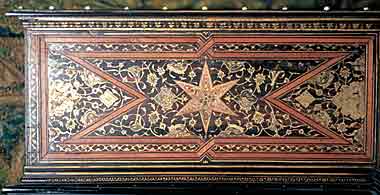
![]() Here is more detail of the Baffo decoration showing a combination of inlaid marquetry banding and painted arabesque decoration, with cypress blackened to resemble the more expensive and exotic ebony.
Here is more detail of the Baffo decoration showing a combination of inlaid marquetry banding and painted arabesque decoration, with cypress blackened to resemble the more expensive and exotic ebony.
Some Venetian virginals were decorated by professional painters with an arabesque style, of which the 'Queen Elisabeth's Virginal' (Victoria & Albert Museum, London; now attributed to Baffo, see my thesis, part 2, pp. 50-51) is probably the best known virginals of this type. Recently Nanke Schellmann discovered a date of 1594 in the decoration. Here is the lesser-known 1572 Floriani virginal (Musée des
Arts Décoratifs, Paris) decorated in a similar style.

Most 16th-century virginals are pentagonal in shape and were made as "inner instruments" (i.e. without an outer case), but for the lower tuono corista pitch = approx. 415 Hz the most advantageous design is the hexagonal virginal made by Floriani, Baffo, and others since this permits slightly longer bass strings.
Several rectangular virginals have survived which were made by Poggi and Bolcioni between 1620 and 1641 in Florence. Their instruments often had split keys to provide notes not normally provided for with meantone-type tunings, usually e flat/d sharp and g sharp/a flat. Checklist of Italian instruments with split sharps at this website. These were mostly made in the false-inner-outer style, as is this virginal, which I have attributed to Poggi (Musikmuseet, Stockholm), one of the 17 virginals now belonging to his opus.
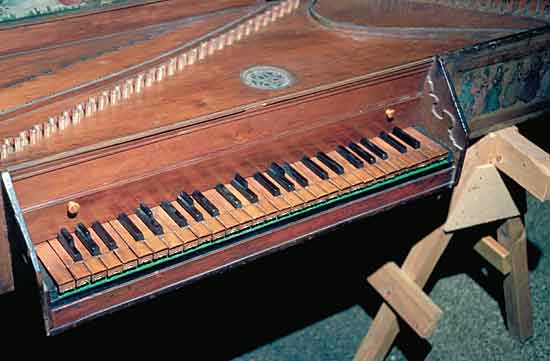
Rectangular virginals were apparently the prevailing style in Naples and there they have the interesting feature that the tuning pins are on the left side of the case. In Guarracino's virginals the left bridge is on the wrestplank so that its contribution to the sound is negligible, in contrast to most virginals which have both bridges on the soundboard. As a result the tone of these instruments is much closer to that of a harpsichord (or bentside spinet) than virginals from other Italian cities.
Trapezoidal virginals were usually only made at 4' pitch, such as this instrument made with an ivory case (W462, Monselice, Italy)
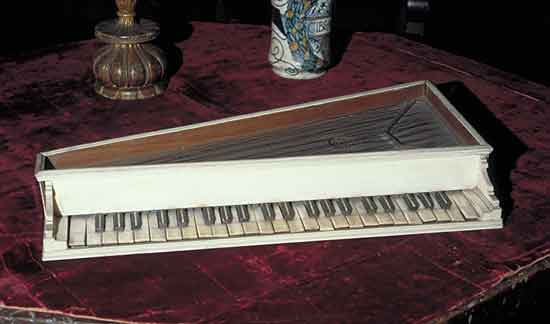
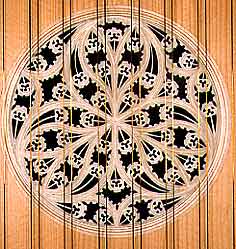
![]() All virginals were provided with a rose, whether carved in the soundboard (as in Brescian virginals) or made of thin cypress veneer reinforced with thin parchment underneath (click here for information on making roses), which was the Venetian tradition. Some were made more simply of parchment, a material which does not demand so much skill for rose
making. I made the rose shown here after one in a Dominicus Pisaurensis virginal.
All virginals were provided with a rose, whether carved in the soundboard (as in Brescian virginals) or made of thin cypress veneer reinforced with thin parchment underneath (click here for information on making roses), which was the Venetian tradition. Some were made more simply of parchment, a material which does not demand so much skill for rose
making. I made the rose shown here after one in a Dominicus Pisaurensis virginal.
Instruments in the inner-outer style can be provided with a plain painted or decorated outer case, or alternatively a lightweight travelling case. False-inner-outer instruments can be decorated in a variety of styles.